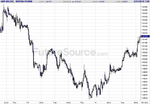more thinking about drawdown
Some more tests and thinking about drawdown, with the help of excel and all the stats I have on my systems.
On average, they trade 8 to 9 times per day, and win 6 out of 10 times.
Now I'll also calculate how much they win vs. how much they lose, simply by a ratio of sum of wins vs sum of losses. Hold on... it wins 350k and loses 200k. Let me do some more math... damn do I suck... let's say that roughly it makes twice as much as it loses, also considering that I'd be using my best systems and not all systems. So, ok, this guy trades roughly 10 times a day, wins 3 out of 5 (or 6 out of 10), but those 3 it wins are twice as big as the 2 it loses. So that's about 3 times 2, which is 6 vs 2. So I guess I could say the system has a profit ratio of 3, according to this formula:
% wins * average win divided by % of losses * average loss
0.6*2 divided by 0.4*1 = 1.2/0.4 = 3
At any rate, in order to further simplify things, I will pretend that my system has equal size wins and losses, and it wins 75% of the time.
The reality, every 5 trades, is like this:
+2
+2
+2
+2
+2
+2
-1
-1
-1
-1
=12-4=8
But to simplify things, I will make it look like:
+1
+1
+1
+1
+1
+1
+1
+1
-1
-1
...what the heck... it doesn't work.
Can we say that winning 60% of trades and having a average win twice as big as an average loss, equals to winning 75% of time and having wins and losses of the same size? Let me think about it again.
The original daily trade hypothetical sequence was like this and it still makes perfect sense until here:
+2
+2
+2
+2
+2
+2
-1
-1
-1
-1
=12-4=8
Oh ok, I see it now... that's like having 16 little 1 point trades, of which 12 win and 4 lose, so it is indeed 75% of 1-point wins. But the problem.. oh, I see why the final profit didn't sum to 8! Because in fact the ratio of wins of 75% is correct, but I still need 16 of them to get a profit of 8. Obviously... but since I suck at formulas it took me this long.
Anyway, once we've established that I can simplify and say my system wins 7.5 times out of 10, I can now see how likely is every day to close with a profit or a loss.
You see, as I was getting dressed, I was thinking that if we had 2000 trades per day, with this ratio, or any profitable ratio, we would be more likely to end the day profitably than if we only had 2 trades per day, because of the law of large numbers or whatever they call it. So here's what I'll do on excel. I will run the random number function, "=random()" or whatever it is, and see how the law of large numbers or whatever it's called plays out over my daily trades.
The mentioned function returns a random number between 0 and 1. Now, in order to pretend there's a 75% of them profitable, I need to pretend that the numbers under 0.25 are the losing trades, and those above it, are the winning trades.
Ok, let's say these are my ten trades:
0,14
0,85
0,98
0,32
0,77
0,04
0,60
0,13
0,65
0,49
As expected, despite the numbers being random, they follow a pattern, the pattern of probability, and the outcome is that 3 numbers are below 0.25, and 7 are above, which of course in my example means 3 trades are unprofitable and so on. So this would be a typical day in my trading, and the outcome of the day would be positive. I will now automate the calculation of the negative vs positive trades and run several days, and see how many of these days are profitable, which simply means they have more than 5 winners, which means more than 5 numbers above 0.25. Then later I will run it on samples of 50 numbers, which corresponds to the amount of my weekly trades. Later I will do 200 cases, which is my monthly trades. This will tell me how likely I am to have unprofitable days, weeks, months.
View attachment profit_probability_according_to_different_time_intervals.xls
Ok, there it is (attachment above). Just to be on the safe side, I also added a sheet where I pretended that my systems were as bad as 60% of wins, with ratio of win/loss of 1 (equal wins and losses). It turned out that, due to the big drawdowns of my systems, this second sheet represents better their performance - not in terms of profit but in terms of regularity of profit. That is, they make a lot more when they win, but they don't win as often as 75% of the time, on a daily basis. I realize it's all more complicated than this, but I simplified it enough for it to be useful to me.
The following summary says it all. With 10 daily trades, after running random numbers for 100 days, here's what I get:
with 75% of wins (numbers above 0.25 being considered "wins")
AVERAGE of WINS
Daily: 7,51 out of 10 trades
Weekly: 37,55 out of 50 trades
Monthly: 150,2 out of 200 trades
Non-profitable days: 6 out of 100
Non-profitable weeks: 0 out of 20
Non-profitable months: 0 out of 5
with 60% of wins (numbers above 0.40 being considered "wins")
AVERAGE of WINS
Daily: 6,02 out of 10 trades
Weekly: 30,1 out of 50 trades
Monthly: 120,4 out of 200 trades
Non-profitable days: 35 out of 100
Non-profitable weeks: 1 out of 20
Non-profitable months: 0 out of 5
This last one is more like my system. Actually my system is even worse, as it will have about 1 unprofitable week every 10. So what can I make of this? I have a much better idea of how the frequency of my trades (combined with % of wins) can affect the likeliness of every day/week/month being profitable.
Overall I would say that my system is almost perfectly represented by the 60% of wins table (second one in the file attached), in that I often see two red days in a row, but almost never a whole red week, and so far never a red month. Now I'll need to see how things change when the daily trades go from 10 to 8, and everything else stays the same (60% of wins).
Now, theoretically, if probability were perfectly played out, out of 100 days with 100 trades in each one of them, even wth just a 51% of wins, 100 days would turn out to be profitable, because we'd have 51 profitable trades out of 100 every day. In the same way, in our test with a 60% of wins, we would have 6 daily wins, and every day would be profitable, but we see that it's not the case, and we have 35 losing days, all compensated by the other days, so that on average we still have 6 daily wins. Let's extend this to hundreds and so on.
View attachment profit_probability_according_to_time_and_trade_intervals.xls
Ok. This time I kept the formulas in, so i can run different tests by simply double-clicking on a cell and the pressing return.
I'll describe what I see by focusing strictly on the 60% of wins sheets, that vary according to daily number of trades. Premise, no matter how many tests I run, the % of wins is always around 60%, regardless of number of unprofitable days. Here's more, in detail by sheet and number of daily trades:
1) 50 daily trades
AVERAGE % DAILY WINS: varies from 59% to 61%
unprofitable days: varies from 6 to 14
2) 10 daily trades
AVERAGE % DAILY WINS: varies from 57% to 63%
unprofitable days: varies from 27 to 49
3) 5 daily trades
AVERAGE % DAILY WINS: varies from 56% to 64%
unprofitable days: varies from 22 to 42 (due to the odd number and the fact that only 3 unprofitable trades or more cause an unprofitable day)
4) 3 daily trades
AVERAGE % DAILY WINS: varies from 55% to 65%
unprofitable days: varies from 24 to 43 (due to the odd number and the fact that only 2 unprofitable trades or more cause an unprofitable day)
What really strikes me about this is that by bring the trades from 50 to 10, given the same % of wins during the whole 100 days, the number of unprofitable days goes from an average of 10 for the 50 daily trades system to an average of 40 unprofitable days for the 10 daily trades system. That is really something to think about.
Tests #3 and #4 are kind of useless, and poorly made, because I used odd numbers and computed unprofitable days with a different logic.
The tendency is clear though. Whereas I can count on the 60% of wins systems to always deliver 60% of wins, as it was obvious from the start, the more they trade, the faster they will bring me that 60%. If they trade once a month, I could have unprofitable years. If they trade 50 times a day, I can pretty much not have any unprofitable days, because even the unprofitable ones are near break-even. Obviously, my system only trades 8 times per day, so I can expect it, on the weekly timeframe, to deliver the daily performance of a system that makes 50 trades per day, which means pretty much no negative weeks. But to ensure this, I'll first have to make sure the CL trades 1 contract while all the other smaller futures trade 2 or more contracts. Only like this I can avoid that the big CL drawdown screw up my daily profit. To the math guys this was obvious from the start, but since I am bad at math, I had to see it on excel.


